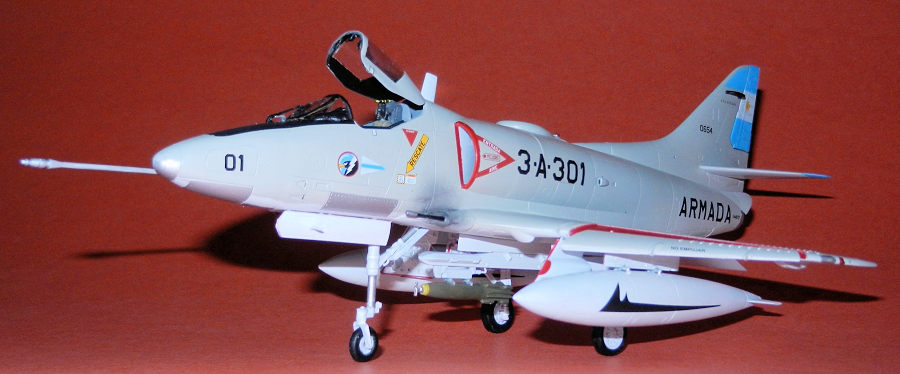
Hobbycraft 1/48 A-4Q Skyhawk
| KIT #: | 1433 |
| PRICE: | $ |
| DECALS: | Three options |
| REVIEWER: | Pablo Calcaterra |
| NOTES: | TD resin seat (48046) |

| HISTORY |
Rodolfo Castro Fox was the Squadron Leader of the 3era Escuadrilla Aeronaval de Caza y Ataque (A4-Q Skyhakws) of the Comando de Aviacion Naval Argentino during the 1982 war in the South Atlantic between Argentina and the United Kingdom.
He received his Wings in 1962 after his 2nd year in the Navy, being one of the 12 survivors of the original group of 120 that had been screened in 1960, of which 36 had been accepted for the first year. Only a few years later he was only one of the two left of his Class.
Castro Fox flew a wide range of planes before and after the war. These were AT-6 Texan, NA SNJ-5C (a navalized version of the Texan), Catalina PBY-5A, Beechcraft C-45-H, AT-11, TA- 4-J, T-34 Turbo Mentor, B-200, Stearman PT-17, hot air balloon among others.
He flew from the airplane carriers ARA Independencia and ARA 25 de Mayo. T-28 “Fennec”, Pilatus Turbo Porter (when delivered to Argentina but he did not flow in operationally), A4-Q (which were basically B models modified to Argentine Navy specs to have IFF, UHF, ADF, a J 65W-20 with 8,000 lbs, ESCAPAC A-1, 3 stations for armament and miscellaneous loads (including AIM-9B) and spoilers.
He
suffered one accident during his times as instructor due to a mistake by his
student. When flying Skyhawks he had two nasty accidents: the first one was
when after getting the Skyhawk to catch one of the arresting wires on the 25
de Mayo the wire broke off due to a deficient welding. The whiplash of the
wire cut the win g
tip and flap and the external wing tank. His inertia allowed him to take off
again. After assessing that the plane was still flyable and with the help of
another A4 pilot who checked that the landing gear seemed to be in good
shape Castro Fox managed to land the plane at their home base in Espora.
Thus he saved the plane and 3-A-303 was flying again later that same year
(1977). A year later the Skyhawks were sent to Southern Argentina to be
ready for the looming war against Chile for the Cape of Horn islands (Picton,
Lennox and Nueva…access to Cape Horn was never denied to Chile but
surprisingly the 3 islands were given to Chile after mediation…which could
technically give them access to the Atlantic when the policy was always
Chile in the Pacific and Argentina in the Atlantic). During these tense
weeks the Navy Skyhawks intercepted Chilean recco planes on the Argentine
side on a couple of occasions. Permission to shoot them down was denied but
the Chileans turned tails and returned to their base.
g
tip and flap and the external wing tank. His inertia allowed him to take off
again. After assessing that the plane was still flyable and with the help of
another A4 pilot who checked that the landing gear seemed to be in good
shape Castro Fox managed to land the plane at their home base in Espora.
Thus he saved the plane and 3-A-303 was flying again later that same year
(1977). A year later the Skyhawks were sent to Southern Argentina to be
ready for the looming war against Chile for the Cape of Horn islands (Picton,
Lennox and Nueva…access to Cape Horn was never denied to Chile but
surprisingly the 3 islands were given to Chile after mediation…which could
technically give them access to the Atlantic when the policy was always
Chile in the Pacific and Argentina in the Atlantic). During these tense
weeks the Navy Skyhawks intercepted Chilean recco planes on the Argentine
side on a couple of occasions. Permission to shoot them down was denied but
the Chileans turned tails and returned to their base.
By now the cartridges of the ejection seats were getting to the end of their shelf life. In 1981 Castro Fox suffered a similar accident to the one in 1977 when flying the same plane. In this case the plane had almost stopped but still had enough speed not to be stopped in time…but also not to take off. Realizing that the plane was going to fall overboard he pulled from the ejection handle. The hood flew off…but not the seat. The plane fell overboard inverted with Castro Fox still in it. Apparently, the hit in the ocean triggered the cartridge and he was ejected with the seat…straight down! Two minutes later he surfaced and was trying to swim with one arm. The other one was broken in many places all the way to the shoulder. The helicopter managed to fish him out after a couple of tries. His heart stopped on two occasions while they were flying him to the hospital. He also had multiple bruises, his lungs were in shock, and concussion…he was in really bad shape. Looks like 303 failed to him…twice!
A slow recovery followed and in December ’81 he was named commander of the 3era Escuadrilla. At this time it was discovered that most of the surviving planes (some had been lost in accidents) had cracks in their wing spars. Also the Air Force lent the Navy 3 ejection rockets. The Navy had stopped investing on the planes because they were going to be replaced soon with the brand new 14 Super Eterndards (though only 5 were received before the war).
On March 26 1982 he was asked to attend an ultra-secret meeting at their command. The Squadron leaders were informed that Argentina was going to retake the Malvinas (Falklands) on April 1. When he asked how the leadership thought the British would react the naïve answer was: “ The English don’t know what to do with the islands…there will be negotiations”. A sign of the things to come…and the failure of the Argentine leadership to assess the wounded pride of the British lion…and history.
Maybe you are aware or not…but on May 1st the Argentine Navy missed a golden opportunity to hit the British Task Force. Having identified the carrier group during the day an attack led by Castro Fox was planned for the following day using 6 x Skyhawks armed with 4 x Snake Eyes and a couple of planes with Sidewinders to cover the attacking planes. It was estimated that two of the attacking planes would be shot down before hitting the target, the other four planes would be able to hit a carrier with no more than 4 bombs (enough to disable it) and the air to air armed planes might be shot down…A plane was in reserve and another one was going to be used in Buddy Pack configuration. In summary, to disable a British carrier less than 50% of the planes would be returning but it was a good price to pay. During that night a Sea Harrier was detected by the Type 42 Argentine destroyers. The British, by chance, had found the Argentines. It was decided to launch the strike as early as possible. And then the unbelievable happened: in one of the oddest weather events ever recorded…there was zero wind on the surface in the area where the 25 de Mayo was operating. The only was for the planes to take off with the full fuel load was to do it with only 1 instead of 4 bombs. As a consequence this was uneconomical and the attack was cancelled. This attack would have followed that made by the Argentine Navy ships (x 3) armed with Exocets. The 25 de Mayo evaded the nuclear subs looking for her due to the use of buoys and navigation on shallow waters and returned to base. The Skyhawks flew to Rio Grande in Tierra del Fuego. From there they attacked the Task Force when they landed the troops at San Carlos starting May 21.
Well known is also their participation in the sinking of HMS Ardent along
with the Daggers of Grupo 6 of Caza
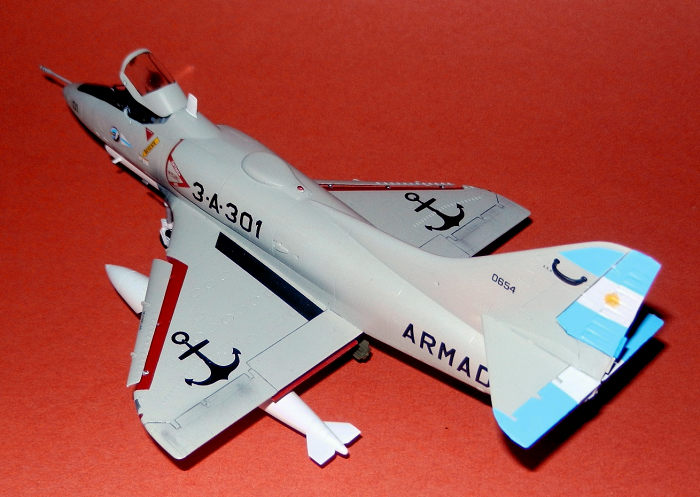 and the
single handed attack of then Capt. Pablo Carballo in his A4-B of the Grupo 5
de Caza of the Argentine Air Force.
and the
single handed attack of then Capt. Pablo Carballo in his A4-B of the Grupo 5
de Caza of the Argentine Air Force.
It must be said that Castro Fox led from the front even though he was still recovering from his injuries sustained the year before. As an example he could not open and close the hood (this was done by the ground crew), choose the selector to actuate the landing gear (he had to cross his right hand over and hold the stick with his left) nor operate any control on the left side of the console in a normal way (he had to crawl his arm backwards using his fingers to push the arm!)
Out of the planes that the Squadron still had left 3 had the spar still cracked, 2 were in maintenance to replace the wings…and the ejection seat cartridges were now expired, something that came back to hit the Squadron a few days later. As the Air Force was getting more Skyhawks in service during the war they asked for a couple of the cartridges. Thus out of the 4 remaining Qs only 3 had good ejection seats and one had an expired one. This plane would have been flown by Castro Fox when leading another attack by the Navy planes on June 14th…when the cease fire was declared (not surrender).
On May 23 and flying 301 (with the Sqn Ldr pennant painted under the cockpit) Castro Fox led a mission to attack the British ships at San Carlos. After refueling from an Air Force KC-130 and receiving information from Capt. Carballo who was returning from the attack to the same target (having sustained one plane shot down – Guadagnini who had hit HMS Antelope with a 1,000 bomb that did not immediately explode -, one damaged (Carballo), one had failed to drop the bombs and one that was returning with no news) Castro Fox flew low over the islands and behind hills to hide from the radars. After jumping the last hill the Argentine Navy pilots saw the British ships…it looked like a normal Argentine Navy deployment…except for the small dark clouds in the air caused by the AA fire. Castro Fox chose a target (HMS Intrepid) and when approaching at full power he saw thru his gunsight that a light coming from the ship was waving in coming towards him. It had been a Sea Cat. He broke hard to avoid it, turned towards the ship and dropped his bombs. The SAM had managed to affect his bomb run and his bombs fell long on the other side of the ship. His wingmen told him that two other SAMS had flown behind his tail missing him. All the Navy Skyhawks returned but with a leak from his tanks Castro took a different slower route. He was the last to arrive to their base and was asked to use one side of the runway instead of landing in the center of it. After landing and while still rolling he noticed another Skyhawk by the runway with the nose landing gear folded. Upon descending from his plane Castro Fox was informed that the plane was Zubizarreta’s (his 2nd in command) who had landed with a bomb still hanging. When the plane’s left tire exploded during landing the plane shifted to that side. About to have a dangerous exit of the runway and with a bomb still hanging Zubizarreta ejected…only to be killed when the expired seat cartridge failed to work properly without giving time for the chute to deploy properly. 3-A-306 not only killed Zubizarretta but on November 1982 it crashed during a night flight killing another Navy pilot…probably one of the few times a plane killed his pilot twice.
After the war Castro Fox commanded the 1era Escuadrilla flying Aer Macchi MB-339A. He participated in several of the launches of the Martin Pescador Air to Surface anti shipping missile.
He was Air Attaché to the Embassy in Germany and made presentations about the 1982 war receiving a military applause of the German audience. This was followed by commanding the Escuela de Aviacion Naval and Chief of the Base Aeronaval Espora. After some other postings he decided to retire in 1996 after 25 years of service with around 6,000 flying hours in multiple aircrafts, 10,700 landings of which 260 had been in the Argentine carriers.#
After his life in the Navy Castro Fox completed a Post Graduate study on Business Management and for 15 years he worked engaging European companies working in aviation. The much admired and professional Rodolfo Castro Fox still resides in Bahia Blanca, Argentina.
| THE KIT |
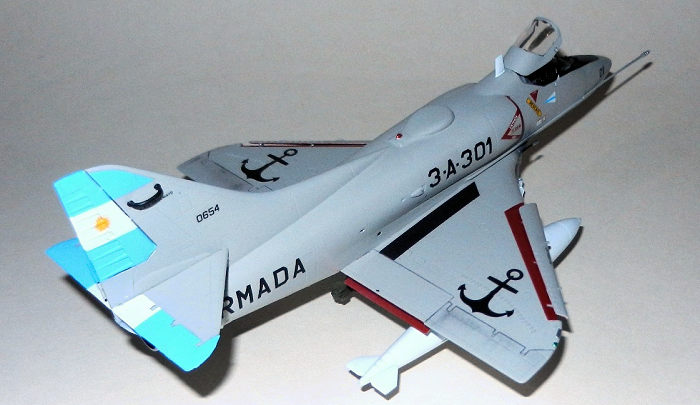 Released
in 2000 Hobbycraft’s line of Skyhawks in 1/48 closed a gap in the line of
A-4s available in the scale. Until the launch of the Hasegawa ones these
were the only B or Cs in the market. Though cheaper, with details not as
petite as Hasegawa’s Hobbycraft Scooters are very good with very good lines
overall.
Released
in 2000 Hobbycraft’s line of Skyhawks in 1/48 closed a gap in the line of
A-4s available in the scale. Until the launch of the Hasegawa ones these
were the only B or Cs in the market. Though cheaper, with details not as
petite as Hasegawa’s Hobbycraft Scooters are very good with very good lines
overall.
Decals for this kit allow the build of several Argentine planes both from the Air Force and Navy plus a Singapore one.
One of the strong points of the HC kits is the presence of armament (several types of bombs). On the minus side the oversimplified and not properly shaped dorsal radome.
| CONSTRUCTION |
The kit gives you all the parts you need to easily build a Skyhawk. The only modification was the replacement of the oversimplified kit’s ejector seat with a resin one. This was left for the last moment.
Fuselage halves closed after the cockpit was put together required a little bit of putty. The radome was modified as the beacon area is incorrect. It does not end up in a sharp tip (tear shaped) but on a squared blunt one. With some putty and plasticard I modified the area to achieve the proper profile.
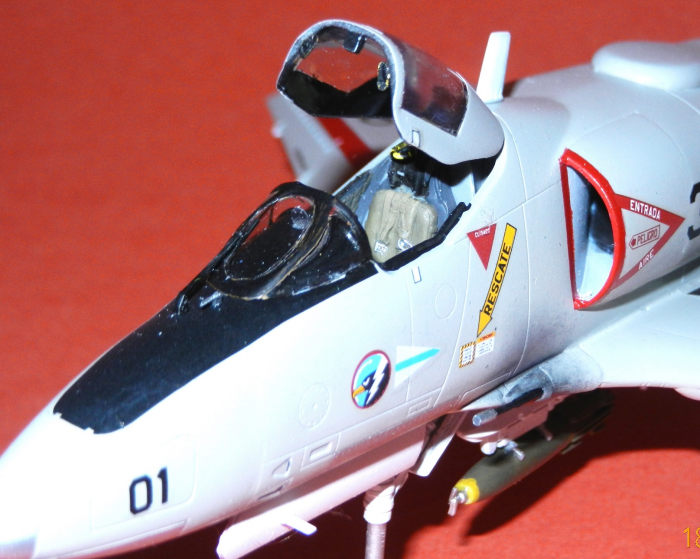 With the
fuselage ready I attached the single piece bottom half of the wings and
immediately the top halves. This allowed me to play with the position of the
3 parts to minimize the tap between top of wings and fuselage. Knowing the
kit from previous projects I knew I had to sand off the spoilers because
they curved too much. If you don’t sand them you end up with a very visible
gap with the fuselage which is even more evident on a light coloured plane.
With the
fuselage ready I attached the single piece bottom half of the wings and
immediately the top halves. This allowed me to play with the position of the
3 parts to minimize the tap between top of wings and fuselage. Knowing the
kit from previous projects I knew I had to sand off the spoilers because
they curved too much. If you don’t sand them you end up with a very visible
gap with the fuselage which is even more evident on a light coloured plane.
Horizontal tail surfaces were next. I painted the internal surfaces of the air intakes in white with the engine area in black. After masking them with Tamiya tape the intakes were attached.
During the missions in the war the Skyhawks used 6 x Snake Eye bombs. I only had 2 available from a Monogram Harrier (thinking about it I could have made 4 more with my usual Plaster of Paris and two part epoxy…but it seems I didn’t not think about it at the time) Finally I attached the landing gear legs.
Drop tanks were put together. The external stations were attached. Canopy and windshield were masked and the plane was ready to be painted.
| COLORS & MARKINGS |
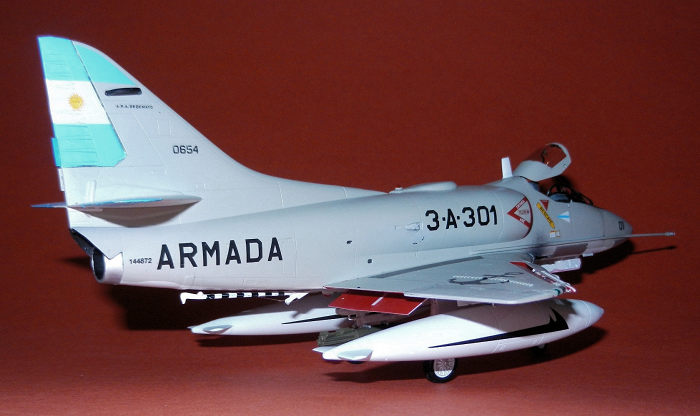 Canopy
and windshield were given a coat of Vallejo black primer. Then everything
received a coat of Vallejo light grey primer.
Canopy
and windshield were given a coat of Vallejo black primer. Then everything
received a coat of Vallejo light grey primer.
Undersides, drop tanks, landing gear, arresting hook, antenna behind the cockpit, rudder and horizonal moveable surfaces were pained with Vallejo Gloss white. Upper surfaces with Model Master 36440. In hindsight I should have painted the light blue areas as well instead of using the kit supplied decals.
Bombs were painted with OD and yellow bands. Different panels under the nose were painted in silver. Intake lips and the internal surfaces of flaps and slats were painted in red. Details were picked up with a sharp pencil and for the smoke stains from the 20 mm gun blasts I used sanded black pastel applied with a Q tip.
After some coats of Future I used the kit decals. The flags in the tail were a bit too large and had to use a lot of Set and Sol to make them conform the ribs of the rudder. Squadron leader (Castro Fox) pendant decals were applied on both sides of the nose. The black anti-glare paint on the nose came from a Hasegawa Skyhawk. Walkways were painted on. Black strips were used for the arresting hook.
| FINAL BITS |
Navigation lights were painted using silver and then clear red and green. I attached the exhaust pipe. Flipping the plane on her back I started from the center moving outwards: bombs, arresting hook, landing gear doors with landing light on the right hand side one, wheels, drop tanks.
With the kit on her legs the following day I installed the ejection seat, painted the reflector gunsight light and added the gunsight itself, the Omega antennas on the tail, the multipart slats, refuelling probe, the windshield with the wiper and finally the open canopy to which I had added photoetched rear mirrors and a scratchbuilt compass. The last part attached was the pitot in front of the windshield.
| CONCLUSIONS |
A very “noble” kit that it’s easy to build and delivers a nice representation of an Argentine Navy Skywhak during those hectic days in 1982. With admiration to Castor Fox who still recovering from his injuries led from the front and with his example.
| REFERENCES |
Yo fui piloto aviador naval (Castro Fox)
Email exchanges with Castro Fox
13 October 2023 Copyright ModelingMadness.com. All rights reserved. No
reproduction in part or in whole without express permission from the editor.
If you would like your product reviewed fairly and fairly quickly, please
contact
the editor or see other details in the
Note to
Contributors.